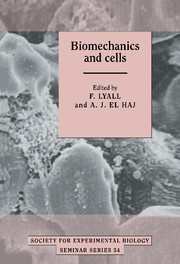Book contents
- Frontmatter
- Contents
- List of contributors
- PART 1 SOFT TISSUE
- PART 2 HARD TISSUE
- Cellular modelling of mechanical interactions with the skeleton
- Mechanical and hormonal influences in vivo cause regional differences in bone remodelling
- Mechanically sensitive cells in bone
- Mechanical stress and bone development
- Application of homogenous, defined strains to cell cultures
- Role of arachidonate in load transduction in bone cells
- Effects of mechanical stretch on actin polymerisation in fibroblasts of the periodontium
- Modulation of cartilage extracellular matrix turnover by pulsed electromagnetic fields (PEMF)
- Index
Effects of mechanical stretch on actin polymerisation in fibroblasts of the periodontium
Published online by Cambridge University Press: 19 January 2010
- Frontmatter
- Contents
- List of contributors
- PART 1 SOFT TISSUE
- PART 2 HARD TISSUE
- Cellular modelling of mechanical interactions with the skeleton
- Mechanical and hormonal influences in vivo cause regional differences in bone remodelling
- Mechanically sensitive cells in bone
- Mechanical stress and bone development
- Application of homogenous, defined strains to cell cultures
- Role of arachidonate in load transduction in bone cells
- Effects of mechanical stretch on actin polymerisation in fibroblasts of the periodontium
- Modulation of cartilage extracellular matrix turnover by pulsed electromagnetic fields (PEMF)
- Index
Summary
Introduction
Periodontal tissues provide support and attachment for the teeth. The periodontium includes two mineralising connective tissues, alveolar bone and cementum, and two soft connective tissues, periodontal ligament and the lamina propria of the gingiva. The fibroblast is the predominant cell type in the soft periodontal connective tissues. This secretory cell synthesises extracellular matrix proteins including fibronectin, glycosaminoglycans (Hassell, Kimura & Hascall, 1986; Bartold, 1987) and a large array of collagens that are the most abundant structural proteins of periodontal connective tissues (reviewed by Narayanan & Page, 1983).
Remodelling of periodontal tissues is up-regulated by the application of mechanical forces which have been demonstrated to increase collagen turnover rates (Birkedal-Hansen, 1988; Sorsa et al., 1992) and to produce elevated levels of chondroitin sulphate in the fluid that drains periodontal tissues (Samuels, Pender & Last, 1993). Rapid turnover of collagens in the matrix of both gingiva (Page & Ammons, 1974) and periodontal ligament (Sodek, 1977) is also essential for continuous attachment of the roots to the alveolar bone.
To balance collagen synthesis and maintain the steady-state, collagen degradation must occur. Two pathways of collagen degradation have been identified: an extracellular collagenase-dependent route and an intracellular pathway independent of collagenase (Murphy & Reynolds, 1985). Notably, conditions of increased physical stress on the periodontal ligament as a result of the mechanical effects of orthodontic force increase collagenase activity in periodontal tissues (Sorsa et al., 1992).
- Type
- Chapter
- Information
- Biomechanics and Cells , pp. 228 - 243Publisher: Cambridge University PressPrint publication year: 1994



